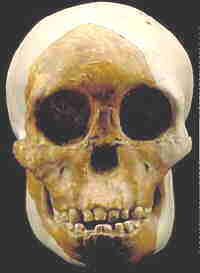 SKC Films Library SKC Films Library |
| SKC Films Library >> Anthropology >> Human Evolution |
| Australopithecus africanus the first hominid to show distinct evidence of an upright posture
The "Taung Child," as the specimen has since come to be known, was a 3- to 4-year-old female who lived 2 to 3 million years ago. In an article written for the February, 1925, issue of Nature magazine, Dart claimed that the "Taung Child" shared several characteristics with modern-day humans. She had a face that was flatter and less projecting than in modern apes; her rounded head lacked brow ridges; the lightly built mandible did not have the space between the lower canine teeth and first premolars found in modern apes; and she had a cranial capacity of 405cc, with a projected adult measurement of 440 cc, slightly larger than that of modern apes. Most important, however, he pointed to the location of the spinal column's connection to the skull, which clearly indicated that this species walked upright. He called the species Australopithecus africanus, meaning "man/ape of southern Africa." Most of Dart's colleagues questioned his claims about the "Taung Child's" lineage. Contemporary thinking had man's direct ancestors arising in Europe, and Dart's find was made in South Africa. In addition, many believed that man had developed his large brain first, and other human-like characteristics later, a belief buttressed by the infamous Piltdown specimen found several years earlier in England. And, since Dart's specimen was obviously that of a juvenile, it made far more sense to the scientific community that it was more likely the skull of a young ancestral chimpanzee or gorilla, since modern-day ape juveniles look remarkably close to human. The only trait they had trouble dismissing was the position of the spinal cord connection. Dart never followed up the initial find with excavations of his own, but others did. Specimens have since been found at three other sites in South Africa -- Sterkfontein, Makapansgat, and Gladysvale. Although the total amount of material is still fairly small, enough has been found to bolster Dart's original claims that Australopithecus africanus belongs somewhere in the human evolutionary line. Just where in the line has yet to be conclusively determined, however. SOURCES SEE ALSO |
| SKC Films Library >> Anthropology >> Human Evolution This page was last updated on 05/25/2017. |
 In
1924, a worker at the Northern Lime Company quarry in
Taung, South Africa, uncovered several bone fragments
that appeared to be human. He took the bones to the
University of Witwatersrand, in Johannesburg, South
Africa, where they came under the scrutiny of
In
1924, a worker at the Northern Lime Company quarry in
Taung, South Africa, uncovered several bone fragments
that appeared to be human. He took the bones to the
University of Witwatersrand, in Johannesburg, South
Africa, where they came under the scrutiny of